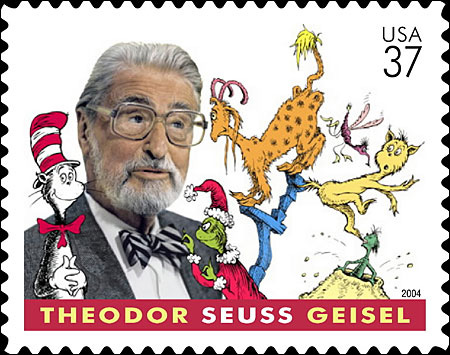The following is from the book Myths: Fact and Fiction about Teaching and Learning by Israel Galindo. How well do you know fact from fiction?
MYTH: The glue in postage stamps used in the U.S. are flavored. This increases sales and makes correspondence a more pleasurable experience.

Theodore Geisel (Dr. Seusss) stamp
TRUTH: Government conspiracy theories aside, the U.S. Postal Service does not add flavoring to postage stamp glue to increase sales.
The glue in postage stamps comes in two varieties: (1) a simple blend of corn dextrin and water is used for commemorative stamps, and (2) for regular stamps, a blend of polyvinyl acetate emulsion, dextrin, and propylene glyco. If that sounds ominous, relax, polyvinyl acetate is the basic ingredient in bubble gum! But if you’re still paranoid you can purchase the peel-off, self-stick stamps for your postage needs.
MYTH: We can assess when a student has learned when he or she can recite from memory the concept being taught, the scripture passage being taught, or the lesson aim, or another piece of information from the lesson.
TRUTH: While memorization is a form of learning, the more important question is, “learning to what extent of understanding?” Reciting from memory can be considered a first and foundational step to higher levels of learning. And, we may need to insist that some things just need to be memorized. To achieve higher levels of learning, however, the teacher should move the learner from mere recitation of facts or repetition from memory. To do this, the teacher can:
- ask the learner to paraphrase
- ask the learner to summarize
- ask the learner to give an example
- ask the learner to give a non-example
- ask the learner to change a picture, chart, or diagram into words (or vise versa)
- ask the learner to interpret meaning
- ask the learner to depict an idea by picture or sculpture
- ask the learner to translate into another language
- ask the learner to judge a concept according to new criteria
- ask the learner to contrast with an opposing idea
Insist on memorization when it is necessary or adds value to learning. But always push for “deep understanding†by facilitating ways for your students to apply, manipulate, interpret, analyze, or use the concepts you are teaching.

You can order a copy of the book Myth: Fact and Fiction about Teaching and Learning by Israel Galindo (ISBN 0-9715765-4-8) directly from Educational Consultants.
